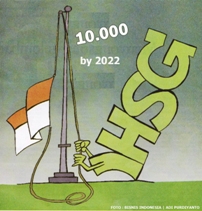
This article is to revisit our market idea “Indonesia Bangkit 2.0,” written on January 6, 2019.
“Strong leadership without guts is irresponsible. Leadership with guts is responsible but probably unpopular.” By “guts” I mean is a preemptive-strike type of policies to guard against future market imbalance before the probability or threat of it becomes imminent. Our current leadership has been viewed by the market as having capacity to do such preemptive jobs before market [creates imbalance].
For example, when President Susilo Bambang Yudhoyono doubled fuel prices in 2005, market called the decision a short term pain for long-term gain; I preferred to call it no guts, no glory (Bisnis Indonesia, 9 January 2006). It shocked the market because it’s not common at the time that the leader came up with strong, preemptive measures in response to budget imbalance. The results? Market started to stabilize and positive momentum was back in track.
What make it now other “guts”?
Since President Joko Widodo took office in 2014, he has experimented on a number of policies which were unconventional but notably spurred economic growth, i.e. tax amnesty and a big infrastructure boost; not to mention was also a ban of a hard-line organization. In his 2nd term, he stoked the market with inclusion of main opposition party into his ally; and enactment of “tough” omnibus law in the middle of Covid-19 pandemic.
These types of unorthodox policies are expected to continue in his 2nd tenure, which are absolutely required to bring back political stability and regain economic expansion.
IHSG is catching up our earlier 10,000 trajectory, why and what are the fundamental reasons?
It’s part of a worldwide risk-on scenario that benefits some emerging markets including Indonesia, but will remain vulnerable to a number of risk-off factors (see the next sub title). First reason is the cycle of low interest rate, which is not merely reflecting very low local inflation thanks to severely lack of aggregate demand due to the pandemic, but is also conditioned by the low world interest rates. This cycle will be here to stay [in most of the world markets] in the next two or three years until economy shows clear sign of re-emergence and stabilization. Furthermore, this low or lower interest rate in Indonesia in my view is intended by BI to strengthen its position to ease up conditions when it wants to monetize debt instruments i.e. by purchasing government debts, for “fear of losing momentum” from speedy debt monetization run by developed central banks.
Second, lower USD currency against IDR is historically beneficial to emerging market debt and equities. If we observe the previous bullish prediction in “Indonesia Bangkit 1.0” article (Bisnis Indonesia, 7 January 2007), combination of low interest rate and weak USD after the great recession of 2007-2008 contributed to the accuracy of our index prediction, when we expected IHSG to reach 2500-3000 by the end of 2008, from 1700 early 2007.
Third is low debt to GDP ratio. By this ratio, developed countries like Japan, US, UK, EU core countries (Nederland, French, Germany, Spain, Italy, Belgium, Greece, Portugal) are the biggest debtors, its debt to GDP is well above 100%. On the other hand, BRIC countries (like Brazil, Russia and India) and some Next-11 economies (Indonesia, Turkey, Vietnam, Bangladesh and the Philippines) are among nations with the least debt to GDP ratios. In the next risk-on cycle the later economies are going to regain momentum, and debt and equity markets are more likely to adjust upward faster.
Fourth, Indonesia is among Next-11 countries which benefits from demography, the fast development in digital economy, and comitted to moving toward zero carbon gradually. Hence, it is preparing for sustainable development goals or the so-called “great reset” initiated by World Economic Forum.
So why IHSG is catching up now. What is the base-case scenario in the medium term? What are the risks?
It is now because market is discounting a possible economic recovery if pandemic is over in 2021. When recovery truly persists, the above fundamentals are essential in the mind of world class investors when they choose or allocate portfolio.
In this scenario my low based trajectory for IHSG is 7500 by 2022, but the previous prediction (see Indonesia Bangkit 2.0, January 6, 2019) of 10,000 level by 2022 isn’t unattainable, and is certainly possible, provided that the following assumptions are true.
- No sudden, substantial reversal of US (developed markets) bond yields, which could lead to fear of market crumble, such as so-called taper tantrum in 2013. It refers to a collective panic that triggered a spike in Treasury yield after the Fed put the break on QE. It created fears of emerging market collapses.
- US-China détente hopes to rise under Biden presidency
- Covid-19 abates after public vaccinations in 2021
- Unclear path of the new Brettonwood proposed by IMF, and the great reset agenda promoted by WEF are among the risks. Are these agenda going to adopt the changing world order or “just as usual” to maintain the current one, how deep they will affect investment risks.
Thank you,
By Djoko Santoso Soenoe, 1 December 2020

Leave a Reply